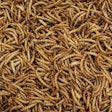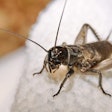
Sticking my hand into a writhing mass of black soldier fly larvae wasn’t new, but seeing millions of squirming infant insects was. And this was just a pilot plant.
Black soldier fly larvae (Hermetia illucens) live in my compost. They help break down the wide range of organic matter that my family discards, from vegetable scraps to coffee grounds. However, the BSFL at Innovafeed’s North American Insect Innovation Center (NAIIC) pilot facility in Decatur, Illinois, eat a select menu. BSFL diet influences the qualities of the pet food ingredients that they will eventually become. Innovafeed must ensure consistent protein and oil production before building a full-scale fly farm.
Innovafeed partnered with the nearby ADM wet corn processing facility to find a buffet for their baby bugs. Innovafeed and ADM are developing an industrial symbiosis to use byproducts from the corn processor to feed the BSFL. Innovafeed runs the world’s largest BSFL production facility in France using industrial symbiosis, Sean Madison, director of North American business development at Innovafeed, told Petfood Industry during a tour of the NAIIC facility. After beginning operations with eggs from the French insect farm, Madison and his colleagues have now reached a point where they can begin harvesting BSFL to extract oil and protein.
These photos follow the lifecycle of the insects through the facility.
Egg Stage (2–4 Days)
Adult female black soldier flies lay clusters of 400–600 eggs in small crevices near decaying organic matter. These eggs hatch within a few days, initiating the larvae stage. At NAIIC, grooved boards replace nooks and crannies near rotting plants and animals.

Larvae Stage (14–16 Days)
The larval stage is critical for BSFL farming. Black soldier fly larvae devour ADM’s corn byproducts, leaving behind a valuable fertilizer called fras. During this stage, the larvae grow rapidly. Likewise, their protein and fat contents increase. Larvae are typically harvested after around two weeks of feeding. At NAIIC, the larvae grow on different wet and dry corn byproduct mixtures. NAIIC biologists are looking for an ideal recipe that will provide strong growth and consistent high yields of protein and oil.


Pupal Stage (7–10 Days)
Once they stop feeding, the larvae enter the pupal stage. They form a hard shell and prepare for metamorphosis into adult flies. During this stage, the nutritional value for feed production decreases, so larvae are rarely harvested after entering the pupal stage. At NAIIC, larvae were allowed to reach the pupal stage as the facility built up its breeding stock. NAIIC now has enough insects to begin harvesting larvae, with only a small percentage going on to pupate.
Adult Stage (5–8 Days)
Black soldier fly adults do not feed and have a short lifespan, focused on reproduction. After emerging from the pupal stage, adults mate, lay eggs, and die within a week. The NAIIC facility has sealed chambers filled with millions of flitting black soldier flies. The flies lay their eggs on grooved boards in the rooms. The dead flies form drifts on the floor.
















